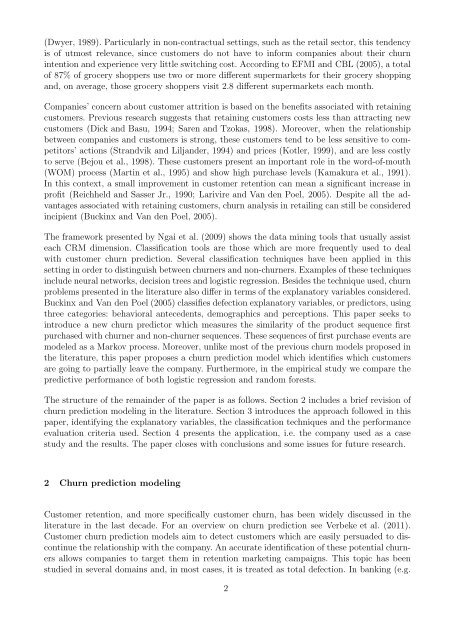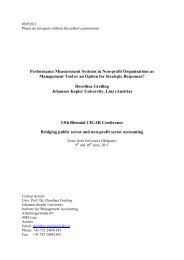Predicting Partial Customer Churn Using Markov for Discrimination ...
Predicting Partial Customer Churn Using Markov for Discrimination ...
Predicting Partial Customer Churn Using Markov for Discrimination ...
You also want an ePaper? Increase the reach of your titles
YUMPU automatically turns print PDFs into web optimized ePapers that Google loves.
(Dwyer, 1989). Particularly in non-contractual settings, such as the retail sector, this tendency<br />
is of utmost relevance, since customers do not have to in<strong>for</strong>m companies about their churn<br />
intention and experience very little switching cost. According to EFMI and CBL (2005), a total<br />
of 87% of grocery shoppers use two or more different supermarkets <strong>for</strong> their grocery shopping<br />
and, on average, those grocery shoppers visit 2.8 different supermarkets each month.<br />
Companies’ concern about customer attrition is based on the benefits associated with retaining<br />
customers. Previous research suggests that retaining customers costs less than attracting new<br />
customers (Dick and Basu, 1994; Saren and Tzokas, 1998). Moreover, when the relationship<br />
between companies and customers is strong, these customers tend to be less sensitive to competitors’<br />
actions (Strandvik and Liljander, 1994) and prices (Kotler, 1999), and are less costly<br />
to serve (Bejou et al., 1998). These customers present an important role in the word-of-mouth<br />
(WOM) process (Martin et al., 1995) and show high purchase levels (Kamakura et al., 1991).<br />
In this context, a small improvement in customer retention can mean a significant increase in<br />
profit (Reichheld and Sasser Jr., 1990; Larivire and Van den Poel, 2005). Despite all the advantages<br />
associated with retaining customers, churn analysis in retailing can still be considered<br />
incipient (Buckinx and Van den Poel, 2005).<br />
The framework presented by Ngai et al. (2009) shows the data mining tools that usually assist<br />
each CRM dimension. Classification tools are those which are more frequently used to deal<br />
with customer churn prediction. Several classification techniques have been applied in this<br />
setting in order to distinguish between churners and non-churners. Examples of these techniques<br />
include neural networks, decision trees and logistic regression. Besides the technique used, churn<br />
problems presented in the literature also differ in terms of the explanatory variables considered.<br />
Buckinx and Van den Poel (2005) classifies defection explanatory variables, or predictors, using<br />
three categories: behavioral antecedents, demographics and perceptions. This paper seeks to<br />
introduce a new churn predictor which measures the similarity of the product sequence first<br />
purchased with churner and non-churner sequences. These sequences of first purchase events are<br />
modeled as a <strong>Markov</strong> process. Moreover, unlike most of the previous churn models proposed in<br />
the literature, this paper proposes a churn prediction model which identifies which customers<br />
are going to partially leave the company. Furthermore, in the empirical study we compare the<br />
predictive per<strong>for</strong>mance of both logistic regression and random <strong>for</strong>ests.<br />
The structure of the remainder of the paper is as follows. Section 2 includes a brief revision of<br />
churn prediction modeling in the literature. Section 3 introduces the approach followed in this<br />
paper, identifying the explanatory variables, the classification techniques and the per<strong>for</strong>mance<br />
evaluation criteria used. Section 4 presents the application, i.e. the company used as a case<br />
study and the results. The paper closes with conclusions and some issues <strong>for</strong> future research.<br />
2 <strong>Churn</strong> prediction modeling<br />
<strong>Customer</strong> retention, and more specifically customer churn, has been widely discussed in the<br />
literature in the last decade. For an overview on churn prediction see Verbeke et al. (2011).<br />
<strong>Customer</strong> churn prediction models aim to detect customers which are easily persuaded to discontinue<br />
the relationship with the company. An accurate identification of these potential churners<br />
allows companies to target them in retention marketing campaigns. This topic has been<br />
studied in several domains and, in most cases, it is treated as total defection. In banking (e.g.<br />
2
















